Estimated reading time: 9 minutes
Key points:
- Increasing temperatures and changes in precipitation are already impacting Northwest forests, with further changes expected in the coming century.
- Northwest forests and woodlands are among the greatest carbon sinks in the United States.
- Drought, wildfire, insects, and disease pose significant risks to many types of forests and woodlands in the Northwest.
- Northwest vulnerability assessments can help managers, producers, and locals to understand how climate change is impacting forests near them.
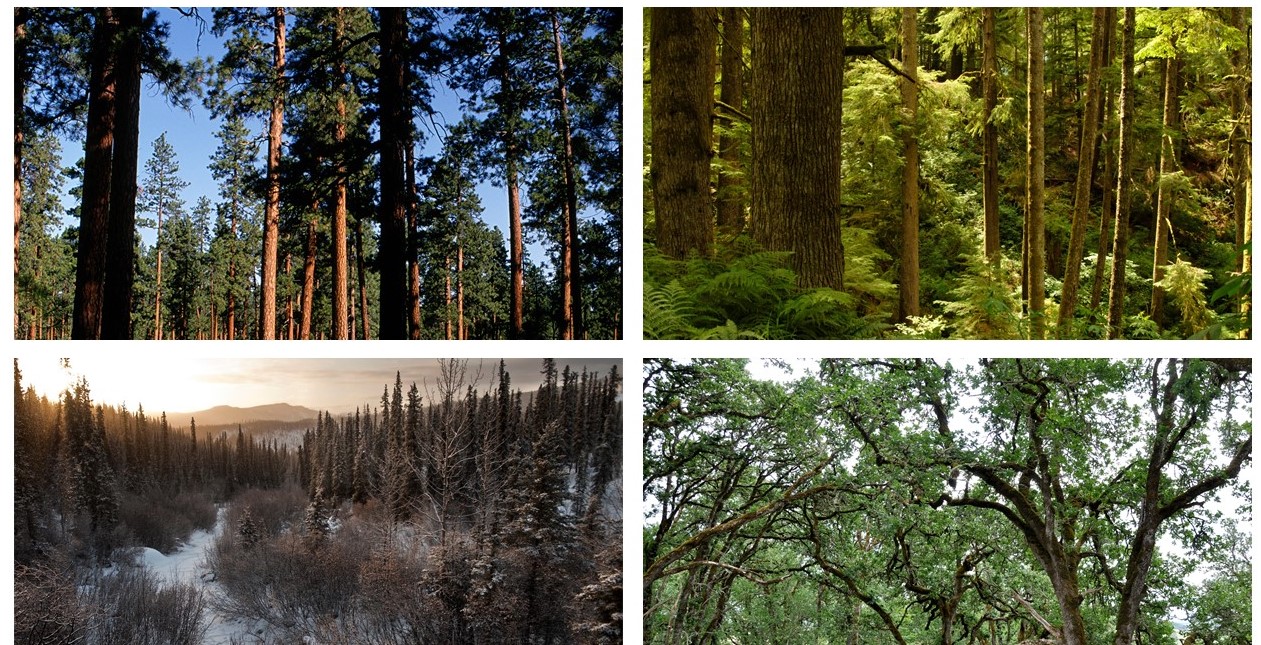 Four of the forest types in the Northwest from top left to bottom right: ponderosa forest, temperate rainforest, boreal forest, oak woodlands. Credit USFS, NRCS, and NPS.
Four of the forest types in the Northwest from top left to bottom right: ponderosa forest, temperate rainforest, boreal forest, oak woodlands. Credit USFS, NRCS, and NPS.
The vast forests and woodlands of Alaska, Idaho, Oregon, and Washington support a sense of place, rural economies, cultural resources, wildlife habitat, and much more within the Northwest Climate Hub region. Near the coast, stands of Douglas-fir, western redcedar, Sitka spruce, and western hemlock tower 100 feet or more in the air, while through much of the interior, juniper and pinyon pine dot woodlands. Black spruce and aspen bow sparingly over Alaskan permafrost, while Oregon white oak grace valley woodlands with crooked shade. Roots, too, network across Northwest forests and woodlands, maintaining thick, biodiverse soil, while trees shelter bears, elk, birds, rodents, and mountain lions, to name only a few of the species that depend on these ecosystems. Humans also rely on Northwest forests to provide timber, food, over half of our water supply, recreational opportunities, bioenergy, and cultural connection.
Northwest forests are among the greatest carbon sinks in the United States. Maintaining forests in Idaho, Oregon, and Washington alone could mitigate years of fossil fuel use in the western United States and enhance biodiversity. However, climate change will likely impact Northwest forests and woodlands and could threaten the services they provide.
How will climate change affect Northwest forests and woodlands?
Climate change projections for the end of the century suggest an increase in average annual temperature of 4.7–10°F in Idaho, Oregon, and Washington, and 2–15°F in Alaska. Precipitation projections are more uncertain than those for temperature. For Idaho, Oregon, and Washington, there is potential for a slight increase in precipitation in the winter and a decrease of precipitation in the summer, along with more extreme precipitation events and drought. Precipitation across most of Alaska is expected to increase by 20.6% by the end of the century under an intermediate scenario (SSP2-4.5), and more extreme precipitation events are likely. Lower snowpack is expected in much of the Northwest, with more precipitation falling as rain than snow, and snowpack melting earlier, resulting in longer dry seasons. Higher temperatures and longer periods between precipitation events are expected to lead to more frequent and severe droughts.
The trees and plants of Northwest forests are locally adapted to climate and tolerate moderate climatic changes. However, rapid and extensive climatic changes like those expected in the coming decades may exceed the capacity of some species to grow, reproduce, and survive. Northwest forests are changing rapidly because of increasing wildfire and insect and disease damage. As temperatures continue to increase, disturbance from drought, wildland fire, insects, and disease may drive further forest ecosystem change. Though some forests in the region could increase in productivity with increased carbon dioxide in the atmosphere and longer growing seasons, disturbances like wildfire and insect outbreaks are likely to offset those increases in productivity. Species will likely move in response to changing climate and disturbance, resulting in novel forest communities in the future. Specific responses to climate change in different forest types are discussed below.
Carbon and Northwest Forests
Though Northwest forests are considered some of the greatest carbon sinks in the United States, climate change could alter the carbon balance of many of these forests. Idaho, Oregon, and Washington have some of the greatest potential to store carbon within North America, and Alaska has 62 percent of the terrestrial carbon stocks found on federal land, and two of the largest forests in the National Forest System. The boreal forest of Alaska stores large amounts of carbon in the roots and trunks of trees. Similarly, permafrost, one of the largest terrestrial carbon sinks in the world, exists beneath much of the soil in the boreal forest. As such, boreal forests account for 20 percent of forest carbon storage in the world.
Forest Types
Broadly, the forests of Alaska, Idaho, Oregon, and Washington include temperate rainforest, dry mixed-conifer forest, subalpine forest, boreal forest, oak woodlands, and pinyon-juniper woodlands. These forests and woodlands are as varied as they are ecologically and culturally significant.
Mountain ranges in Idaho, Oregon, and Washington affect where precipitation falls and create different climates that affect the types of trees and plants found in forests. Topography and elevation also play a role in forest composition. Over 85 percent of forests in Idaho, Oregon, and Washington are dominated by coniferous trees. Douglas-fir is the most common tree in all three states. In Alaska, boreal forests cover the permafrost-underlain interior, and temperate rainforests occur in the Southeast, where it is warmer and wetter. Each forest type has a set of defining characteristics, disturbances, and responses to a changing climate.
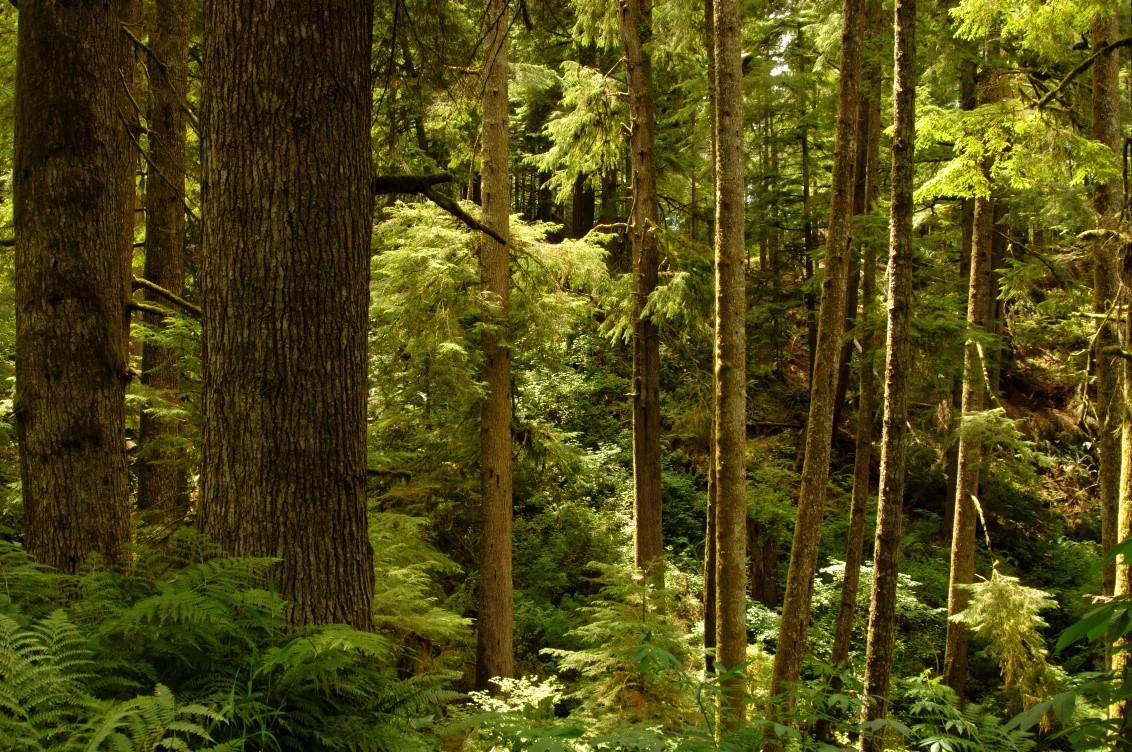 A temperate rainforest in Washington. Credit NPS.
A temperate rainforest in Washington. Credit NPS.
Alaska, Oregon, and Washington are home to one of the rarest forest types in the world—the coastal temperate rainforest. The moist and temperate rainforests west of the Cascade Range in Oregon and Washington and from the Kenai Peninsula to Southeast Alaska support red alder, mountain hemlock, western hemlock, Sitka spruce, Alaska yellow cedar, bigleaf maple, and western redcedar, to name a few. Temperate rainforests are cooler but receive as much precipitation as tropical rainforests. More than 170 inches of rain falls per year in Washington and Oregon, and 200 inches of rain falls per year in Southeast Alaska. High precipitation makes wildfires extremely rare. This allows some trees to reach more than 300 years in age. The primary disturbance in these forests is wind, which can topple older, larger trees and create openings in the canopy that benefit younger, smaller trees.
Climate projections suggest that iconic trees like Sitka spruce and western hemlock could be replaced by more drought resistant trees in the future. In Alaska, trees with higher recruitment rates, like black and white spruce, might replace Sitka spruce and western hemlock. In Oregon and Washington, the persistence of Sitka spruce will depend on the persistence of coastal fog, which is uncertain. Drought-intolerant species like western hemlock will likely decrease with higher temperatures and more drought. Douglas-fir will likely continue to prosper in coastal forests. Changes to the types of trees that grow in forests could affect regional ecology and economics. As the climate continues to warm, insect infestations, such as spruce beetle outbreaks in Alaska, could intensify.
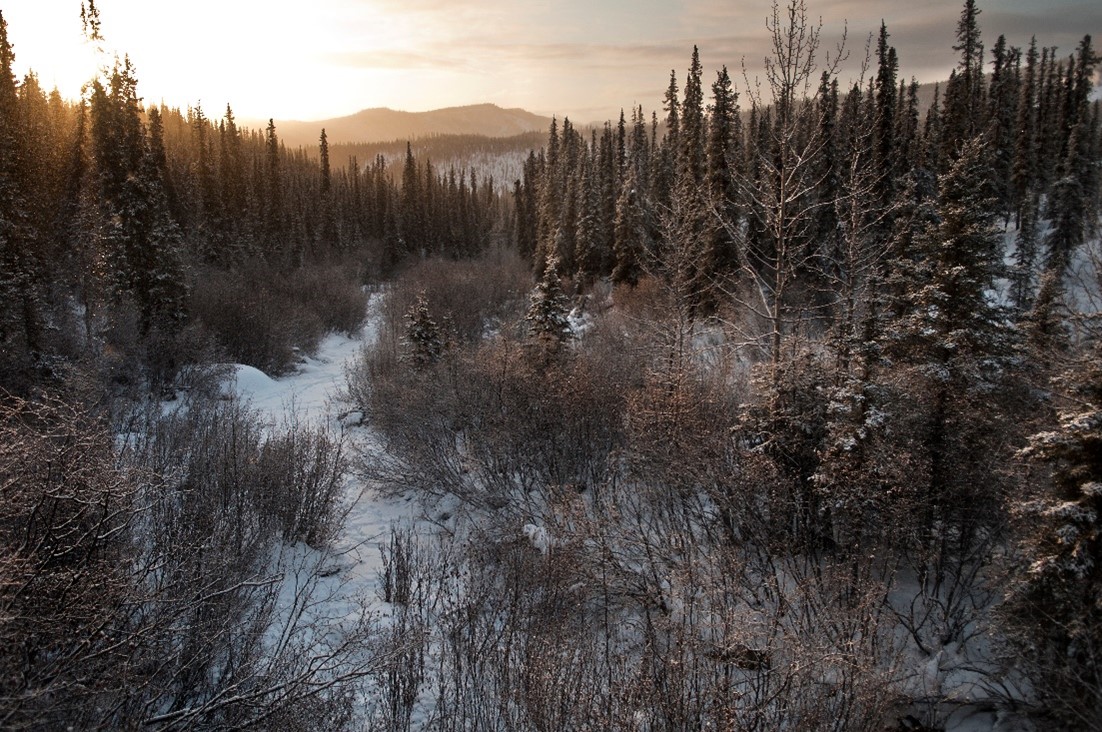 The boreal forest in winter. Credit USFS.
The boreal forest in winter. Credit USFS.
In the United States, the boreal forest stretches south from Alaska’s Brooks Range to the northern edge of the Kenai Peninsula. The boreal forest covers 60-70 percent of the forested land area in Alaska. In the boreal forest, the temperature remains below freezing for 6-8 months of the year. As such, only a few, cold-tolerant tree species, such as black and white spruce, can survive. However, rising temperatures and the increasing frequency of large fires in Alaska are causing a shift from coniferous to deciduous trees. Older spruce forests are giving way to deciduous forests with trees like birch and aspen. Wildfires also threaten to release carbon stored in the trunks and roots of boreal trees, as well as the thawing permafrost beneath them. Invasive species such as earthworms, mountain pine beetle, and Siberian moth could move farther north and spread quickly in a warming climate. New invasive species could introduce new threats to boreal forests. Even native species like spruce beetle are becoming more problematic as the climate warms. Notably, these changes could cause the boreal forest to transition from a carbon sink to a carbon source in years to come.
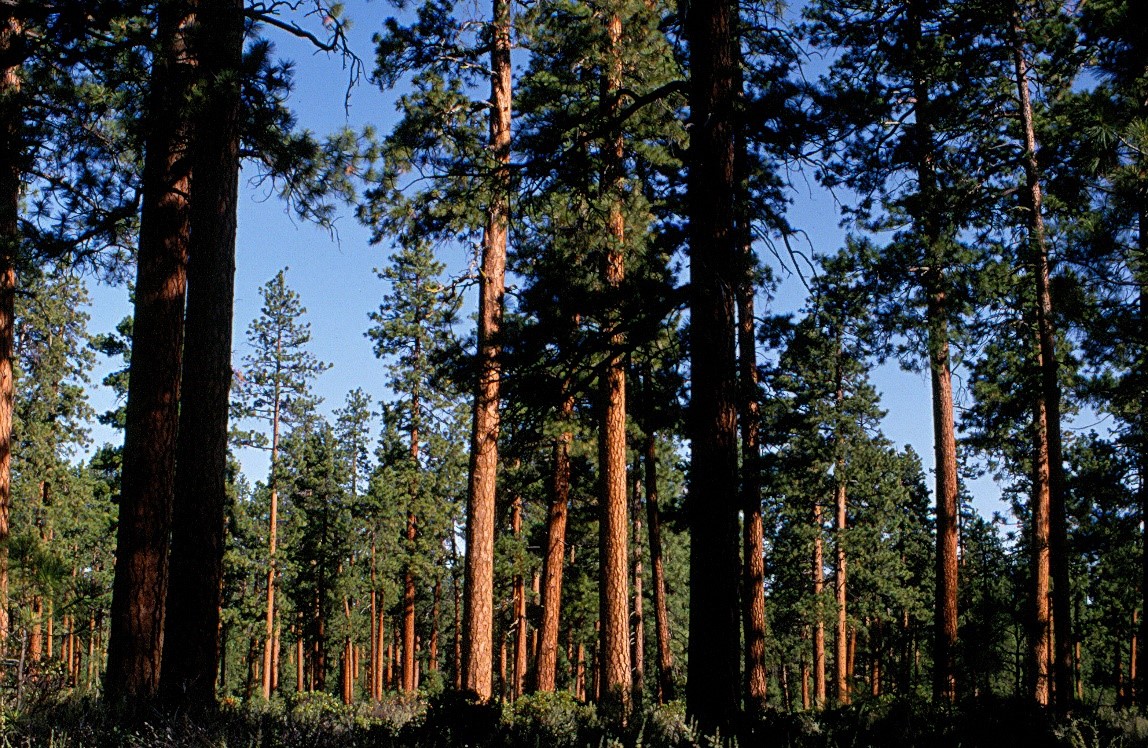 A ponderosa forest in Idaho. Credit USFS.
A ponderosa forest in Idaho. Credit USFS.
The inland Northwest (east of the Cascade Mountains) receives limited precipitation in comparison to forests along the coast. As a result, forests in the inland Northwest are largely made up of shade-intolerant trees that can handle less moisture (e.g., ponderosa pine, lodgepole pine, Douglas-fir, western larch, grand fir, and quaking aspen).
Ponderosa pine and dry, mixed-conifer forests are accustomed to frequent low- and mixed-severity fires. In some cases, these forests actually need fire for tree seed dispersal (e.g., ponderosa pine and lodgepole pine). However, for much of the last century, fires were suppressed in these forests, resulting in denser forest stands. This fuel accumulation makes forests more susceptible to insect infestations, disease, and intense wildfires. As understanding of these forests’ relationship with fire improves, land managers are working to bring fire back to portions of dry mixed-conifer forests to improve forest health and reduce the risk of catastrophic wildfires.
In a warming climate, some dry forest species may move to cooler habitats, including higher elevation areas. Water availability will determine where these forests establish and how successfully they grow in the future. Compounding stresses, like insects, disease, and drought, could lead to widespread mortality in the current range of dry forests.
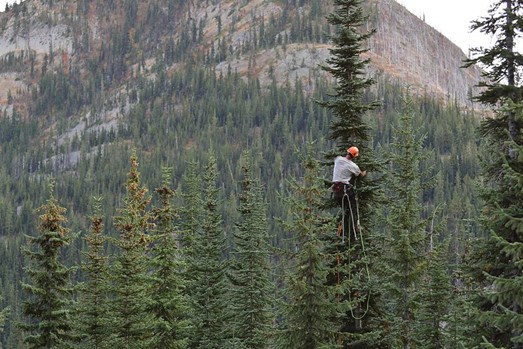 A tree surveyor climbs a subalpine fir in a subalpine forest in Washington. Credit USFS.
A tree surveyor climbs a subalpine fir in a subalpine forest in Washington. Credit USFS.
The subalpine forests of the Northwest typically exist in high-elevation locations throughout Idaho, Oregon, and Washington. Dominant tree species include limber pine, whitebark pine, Engelmann spruce, mountain hemlock, and subalpine fir. These hardy trees sit just below tree line and endure strong winds, heavy snowpack, and freezing temperatures.
With rising temperatures and decreasing snowpack, growth of trees in subalpine forests may increase. Trees from lower elevations may also become more competitive. Though subalpine forests are protected by snow for much of the year, wildfire can act as a significant disturbance in these ecosystems. In the rare events when wildfires occur in subalpine forests, they often occur as stand-replacing events. Currently, subalpine forests are burning at a higher rate than any other forest type in Idaho, Oregon, and Washington. In a changing climate, these forests could be particularly susceptible to vegetation shifts due to snowpack loss, drought, wildfire, and other disturbances, such as insect outbreaks.
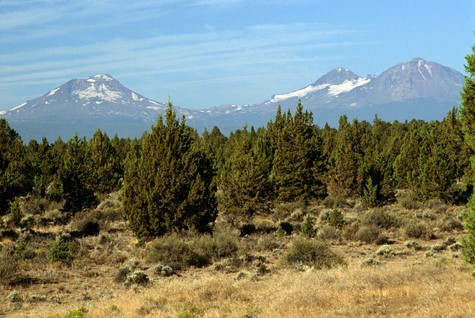 Juniper woodlands in Oregon. Credit USFS.
Juniper woodlands in Oregon. Credit USFS.
Western juniper woodlands are widespread in central Oregon, south-central Washington, and southwestern Idaho. Western juniper, the dominant tree of these woodlands, prefers drier habitats. There are a number of old-growth juniper stands in the region that exceed 1,000 years in age.
A number of factors, including fire exclusion and removal of fine fuels by grazing livestock, have allowed Western juniper to colonize sagebrush steppe areas in southeastern and central Oregon and southern Idaho, threatening sagebrush-reliant species like sage grouse. Juniper encroachment has also been linked to increased erosion and reduced spring and streamflow, impacting water quality. It is unclear, however, whether juniper encroachment is related to the impacts of climate change in the Northwest, since its effects were documented over 130 years ago. The expansion of post-settlement juniper woodlands could cause an increase in high-severity fires in these areas. In warmer and drier sites, juniper are exhibiting die-off, making these areas more susceptible to invasion by annual grasses like cheatgrass.
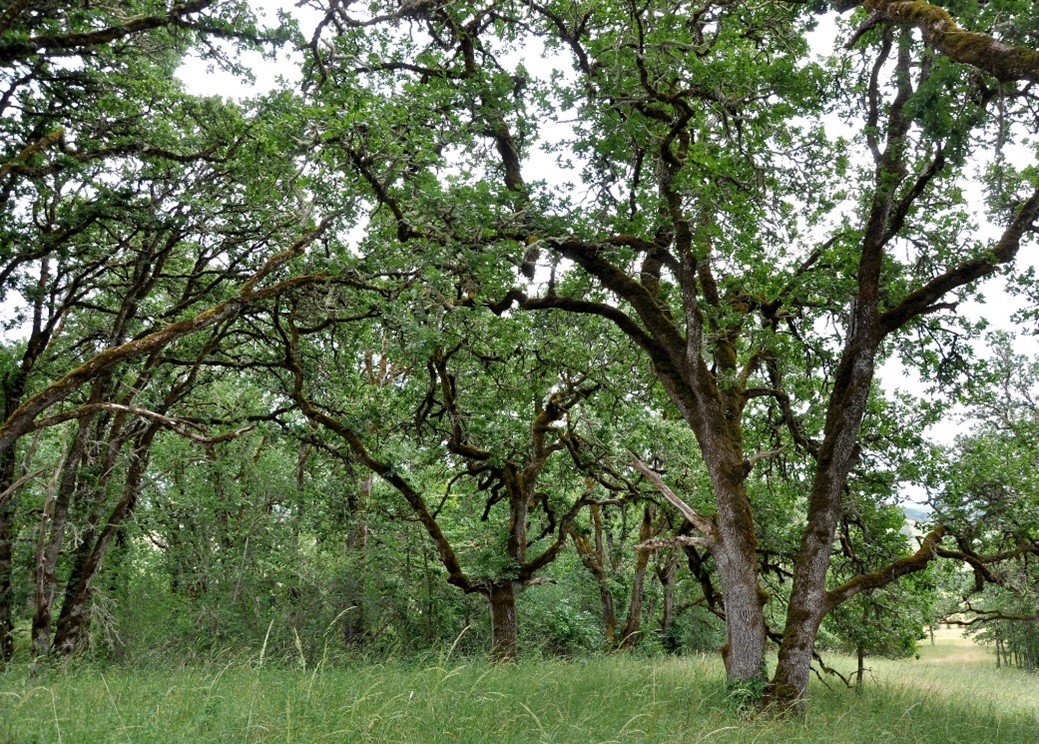 Oak woodlands in Oregon. Credit Tracy Robillard, NRCS Oregon.
Oak woodlands in Oregon. Credit Tracy Robillard, NRCS Oregon.
The oak woodlands of Washington and Oregon support Oregon white oak, ponderosa pine, California black oak, and increasingly, Douglas-fir. They occur in dry, lowland sites and act as transitional zones between prairies and conifer-dominated forests. Oregon white oak is accustomed to hot and dry conditions and is highly drought tolerant. Since the cessation of Indigenous burning in the mid-1800s, many oak woodlands have experienced degradation and habitat loss to encroaching conifers and shrubs. As such, oak woodlands have been designated as a habitat of greatest conservation need by the Washington Department of Fish and Wildlife and as a significant habitat for Oregon species of greatest conservation need.
As the climate continues to change, Oregon and Washington are expected to experience hotter, drier summers and wetter winters, both of which the Oregon white oak can withstand. Increases in fire frequency are also likely to favor oaks. As such, oak woodlands may expand with climate change in the Northwest. However, loss of this habitat is associated with conversion to other land uses, such as agriculture and timber, invasive species, and fire suppression. Much of the remaining oak woodlands are in private ownership, meaning that cooperative approaches are crucial to conservation, particularly because oak woodlands require active management.
Additional Resources
To learn more about Northwest forest vulnerability to climate change, view the resources below to find the climate change vulnerability assessment specific to your area.:
Colville and Okanogan-Wenatchee National Forests
Columbia River Gorge National Scenic Area and Mt. Hood and Willamette National Forests
Intermountain region Part I and Part II
Northern Rockies Part I and Part II
Assessing vulnerabilities and adapting to climate change in northwestern U.S. forests is a scientific publication that reviews climate impacts, vulnerabilities, and management actions for western resource managers.
Upcoming Vulnerability Assessments:




